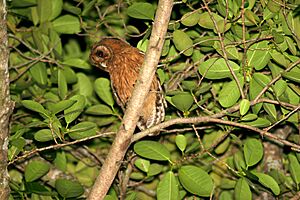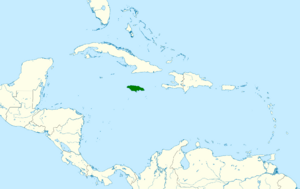Jamaican owl facts for kids
Quick facts for kids Jamaican owl |
|
|---|---|
 |
|
| Conservation status | |
| Scientific classification | |
| Genus: |
Asio
|
| Species: |
grammicus
|
 |
|
| Synonyms | |
|
Pseudoscops grammicus Kaup, 1848 |
|
The Jamaican owl (Asio grammicus) is a type of medium-sized owl. It lives only on the island of Jamaica. This means it is endemic to Jamaica.
Contents
About the Jamaican Owl's Family Tree
Scientists study how animals are related. This is called taxonomy. The Jamaican owl used to be in its own special group called Pseudoscops. But now, after looking closely at its family tree, scientists have moved it into the Asio group, which includes other owls. This owl is also monotypic, meaning it's the only species in its specific group.
What Does the Jamaican Owl Look Like?
The Jamaican owl is about 27 to 33 centimeters (11 to 13 inches) long. One owl was found to weigh about 335 grams (11.8 ounces).
This medium-sized owl has long ear tufts on its head. It has dark brown eyes and a reddish-brown face. This face is outlined with white feathers that have small black spots.
The feathers on the adult owl's back are reddish-brown with thin, wavy dark brown lines. Its tail is also reddish-brown with dark brown stripes. The chest and belly are reddish-brown with thin dark brown streaks. Young owls have a light grayish-brown back and light cinnamon-buff feathers everywhere else.
Where Does the Jamaican Owl Live?
The Jamaican owl can be found all over the island of Jamaica. It likes to live in many different open or partly open places. These include open woodlands, the edges of forests, plantations, and gardens.
It mostly lives in areas near the coast and in lower lands. However, you can also find it in the mountains, sometimes as high as 600 meters (2,000 feet) up.
How the Jamaican Owl Behaves
What Does the Jamaican Owl Eat?
The Jamaican owl is a nocturnal animal, meaning it is active at night. It mainly eats large insects. Its diet also includes spiders, amphibians like frogs, lizards, and rodents like mice. There is one record of it catching a bird called a Greater Antillean grackle.
Jamaican Owl Reproduction and Life Cycle
Not much is known about how the Jamaican owl breeds. People have seen them nesting between March and October. They lay their eggs between December and June. A female owl usually lays two eggs. They build their nests inside a tree hole or in a hidden spot where tree branches split.
What Sounds Does the Jamaican Owl Make?
Adult Jamaican owls make a "high, quivering hoot." They also make a deep, rumbling "guttural growl."
Is the Jamaican Owl in Danger?
The IUCN (International Union for Conservation of Nature) has looked at the Jamaican owl. They have listed it as "Least Concern." This means it is not currently considered to be in danger of disappearing.
The owl is thought to be common and found in many places. However, cutting down forests has likely reduced the areas where it lives and its total numbers.


